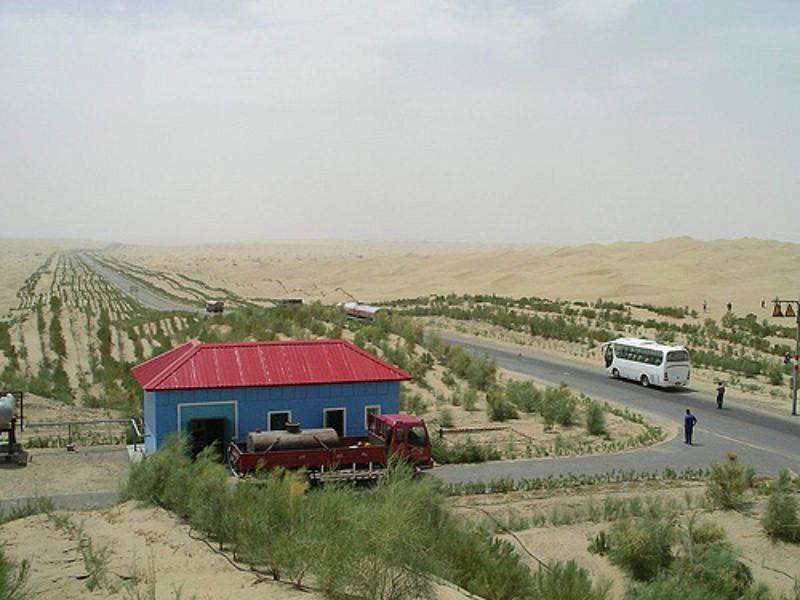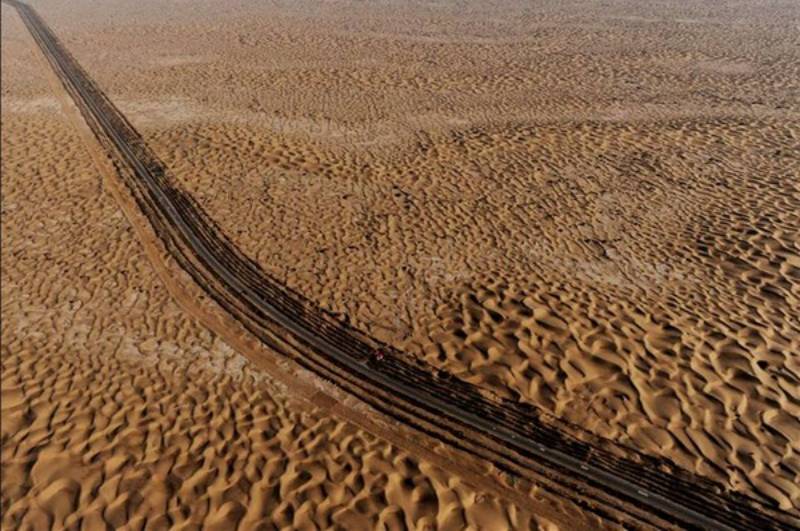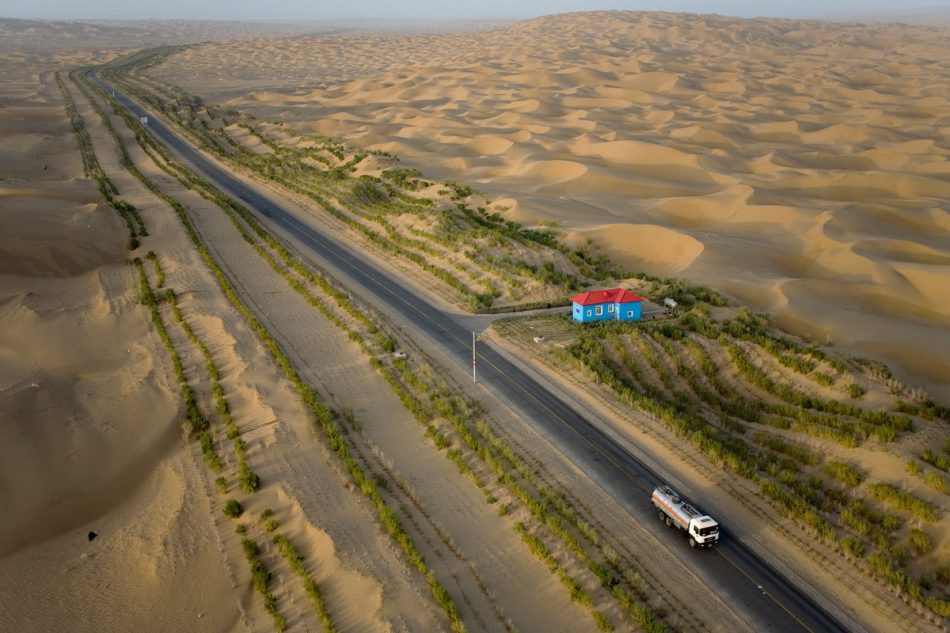The Tarim Desert Highway, also known as the Taklamakan Desert Highway, is a remarkable road that cuts through the vast and desolate Tarim Desert in China. Spanning a distance of approximately 522 kilometers (324 miles), this highway offers an unforgettable journey through one of the harshest and most mysterious landscapes on Earth.
| Country | China |
| Provincia | Xinjiang Uygur Autonomous Region |
| Distance | 522 kilometers (324 miles) |
| Linking cities | Luntai y Minfeng |
Location and Route
The Tarim Desert Highway is located in the Xinjiang Uygur Autonomous Region in northwestern China. It stretches from the city of Minfeng in the south to the city of Luntai in the north, traversing the heart of the Tarim Desert. The highway serves as a vital transportation link, connecting remote towns and settlements in this otherwise isolated region.
History

The history of the Tarim Desert Highway is intertwined with the development and exploration of the Xinjiang region in northwestern China. The construction of the highway began in the 1950s as part of China’s efforts to improve infrastructure and connect remote areas. The challenging task of building a road through the harsh and inhospitable Tarim Desert presented numerous engineering and logistical hurdles.
The highway played a crucial role in opening up the region, facilitating trade, and connecting isolated communities. It served as a vital transportation link for the transportation of goods, resources, and people. Over the years, the highway has undergone several expansions and improvements to accommodate increasing traffic and to enhance connectivity in the area. Today, it stands as a testament to human ingenuity and perseverance in conquering the challenging terrain of the Tarim Desert.
More roads in China: The Floating Bridge of Shiziguan
With its rich history and significance, the Tarim Desert Highway serves as a symbol of human triumph over adversity. It has not only provided practical transportation benefits but has also contributed to the economic development and cultural exchange in the Xinjiang region. The highway stands as a testament to the determination of the people and their desire to connect, explore, and conquer the vast expanse of the desert.
After its construction, authorities realized a significant problem. As a desert of shifting sands, day by day and inch by inch, the sand would bury the road, making it dangerous and often impassable. To protect it from the sand, rows of vegetation were planted on both sides of the road, acting as a barrier against the sand and keeping the road clear. In addition to that, an extensive irrigation network was established to sustain this artificial ecosystem, and water was pumped from underground reservoirs to distribute along the vegetation belt. Despite the high saline content of the groundwater, this green belt has been successful and continues to function.
In addition to this, every 4 kilometers, the Chinese government built houses to accommodate families working in the maintenance and care of the reforestation process of the belt. The workers sign up for periods that can last up to two years since the solitary life that awaits them will be very challenging, and it is not advisable to prolong it for a longer time. Living on a highway, in the middle of a desert where only a few trucks pass by each day.
Challenges and Unique Features

Traveling along the Tarim Desert Highway is no easy task. The desert itself is one of the largest and driest in the world, with shifting sand dunes and extreme temperatures. The highway encounters numerous challenges, including sandstorms, strong winds, and unpredictable weather conditions. It requires careful planning, proper vehicle preparation, and adherence to safety precautions.
Despite these challenges, the Tarim Desert Highway offers breathtaking and unique features. The surrounding landscape is a mesmerizing mix of endless sand dunes, barren plains, and rugged mountains in the distance. The highway provides travelers with awe-inspiring panoramic views, showcasing the raw beauty of the desert.
Points of Interest
Along the Tarim Desert Highway, there are several points of interest that offer a glimpse into the region’s rich history and culture.
- One notable stop is the Ancient City of Niya, an archaeological site dating back to the Silk Road era. Visitors can explore the well-preserved ruins and artifacts, providing insights into the ancient civilizations that once thrived in this area.
- Another point of interest is the Tarim Oilfield, one of the largest oilfields in China. It serves as a significant source of energy and economic development in the region. Travelers passing through can witness the massive infrastructure and operations associated with oil extraction.
Tips for Drivers & Travelers
If you’re considering a journey along the Tarim Desert Highway, here are a few tips to enhance your experience:
- Prepare for the Desert: Pack essential supplies, including food, water, and emergency equipment. Make sure your vehicle is in excellent condition and equipped for off-road travel.
- Timing and Weather: Plan your trip during favorable weather conditions, as extreme temperatures and sandstorms can pose challenges. Spring and autumn are generally more suitable for travel.
- Cultural Sensitivity: Respect the local culture and customs of the Xinjiang region. Learn about the local traditions, and be mindful of local sensitivities.
- Safety First: Follow safety guidelines, stay on designated roads, and inform others about your travel plans. Be cautious of wildlife and other potential hazards.
The Tarim Desert Highway offers a captivating adventure for those seeking to explore the mesmerizing landscapes of the Tarim Desert. It presents both challenges and rewards, allowing travelers to experience the beauty and mystique of one of the world’s most fascinating desert regions. Embark on this journey, and you’ll be rewarded with unforgettable memories and a deeper appreciation for the wonders of nature.
Taklamakan Desert

The Taklamakan Desert spans an area of 270,000 km², which is more than half the size of Spain and roughly equivalent to the size of Ecuador. The temperature is extreme, ranging from -40 °C to 50 °C, and two branches of the Silk Road traverse its northern and southern sides.
Within the desert, various oases can be found, with the most important ones being Kasgar and Yarkand in the southwest, Kuqa and Turpan in the north, and Loulan and Dunhuang in the east.
The desert is surrounded by tall mountains, which give rise to rivers flowing down from high altitudes, resulting in the desert having astronomical amounts of underground water resources. The Chinese government is currently studying how to harness these resources.


 (6 votes, average: 4.83 out of 5)
(6 votes, average: 4.83 out of 5)










